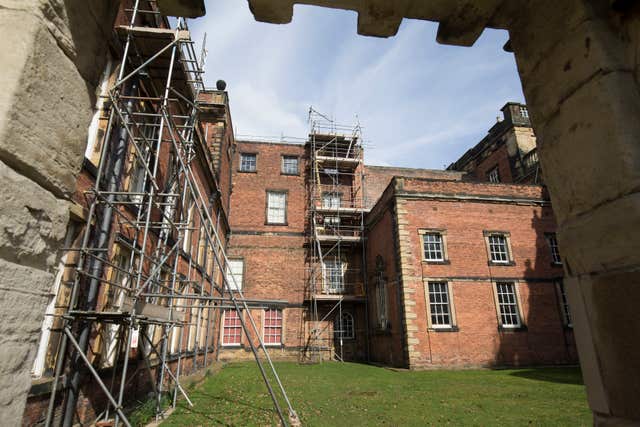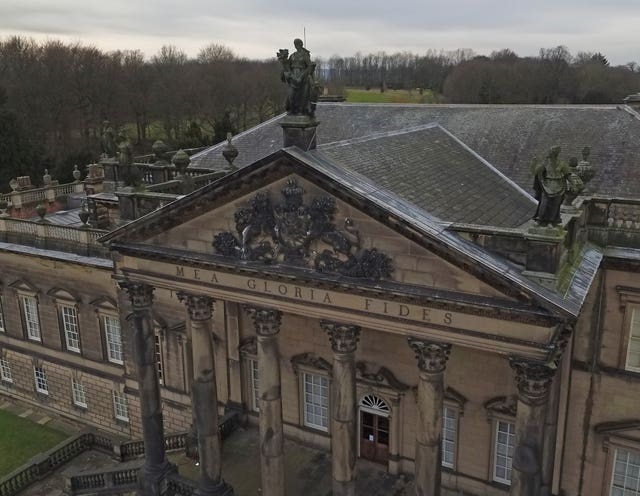
A vast mansion which was once Britain’s biggest private home has been encased in scaffolding as specialist contractors begin the task of replacing its six-tennis-court-sized main roof.
The emergency repairs at Wentworth Woodhouse, South Yorkshire, are the first phase of a £130 million programme to save the building, whose 606ft frontage is wider than Buckingham Palace.
Since Christmas, teams of contractors have used 700 tonnes of scaffolding, including 50km of poles, to wrap the East Front of the house in a 30m (98ft) high metal case.
Work has already begun on emergency stone repairs, including removing 19 urns from the edge of the roof, each weighing in at 600kg, the size of an adult polar bear.
Now the team from contractors Woodhead are preparing to work on some of the building’s 4.2 acres of worn out roofs which will involve 65 tonnes of new Westmoreland green slates over the main state rooms.
Wentworth Woodhouse Preservation Trust chief executive Sarah McLeod said the public will be allowed on the roof scaffolding from next month, once the final protective canopy has been completed.
Ms McLeod said the roof above the state rooms alone will require 14,000 new slates and this work will involve a section the size of six tennis courts.

“It’ a massive undertaking,” she said.
“This particular part of the project is about £5 million.
“It’s a drop in the ocean in terms of the total project but, nevertheless, it’s a really important part because what it ensures is that we’re watertight.
“That’s what really causes damage in these properties when water is allowed to come in.”
She said the 135 steps to the top of the scaffolding will be “not for the faint-hearted” in the public tours but there will be a lift for disabled access.
“We really want to make sure with the project that public get to see what we’re going,” Ms McLeod said.
“Wentworth Woodhouse and this project belong to us all. It belongs to the nation, for the nation.
“So we want to ensure that people see how the money is being spent.”
Ms McLeod said it was important to remember that this phase of the project is just about emergency repairs to stop any further decay.
She said the substantial conversation project should begin at the end of next year with work on the derelict Camellia House, which is due to house a restaurant and other facilities.
The masterplan is to transform Wentworth Woodhouse into a place with a core “visitor offer” centred on the state rooms, plus commercial activities like events, weddings and restaurants.
“I’d like to think I’ll retire in 12 years so I’d like to see the bulk of it done before I go,” Ms McLeod said.
“Realistically, it will all come down to funding.
“£130 million is an awful lot of money but it is achievable and I think the important thing is that we really keep the momentum going.”
Wentworth Woodhouse was one of great mansions of Georgian England but slid into neglect and disrepair during the second half of the 20th century.
The building is actually two grand houses, built back-to-back.

The baroque West Front was built for the 1st Marquess of Rockingham from about 1725 but it is the slightly later, 606ft wide, Palladian East Front which is the behemoth.
One room was created to house Stubbs’s famous painting of the family’s racehorse, Whistlejacket.
The work was sold to the National Gallery for £11 million in 1997.
The 60ft square Marble Saloon was called the finest Georgian room in England.
More than 1,000 people were employed by the house and estate in the mid 19th century, including a “rat catcher” and “state bed maker”.
The house was bought by the Wentworth Woodhouse Preservation Trust in 2017 for £7 million.


Comments: Our rules
We want our comments to be a lively and valuable part of our community - a place where readers can debate and engage with the most important local issues. The ability to comment on our stories is a privilege, not a right, however, and that privilege may be withdrawn if it is abused or misused.
Please report any comments that break our rules.
Read the rules here